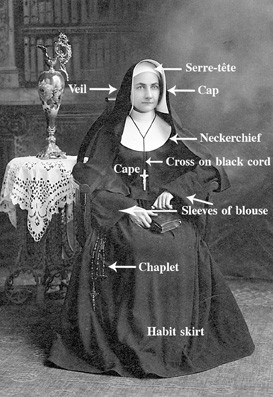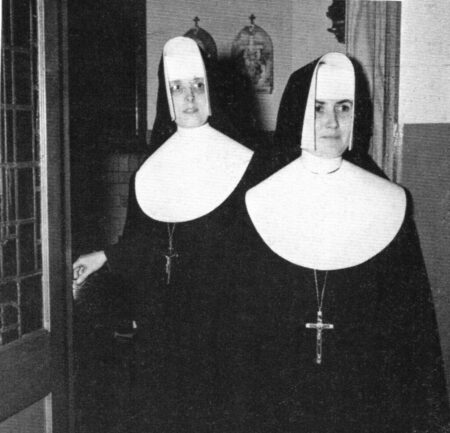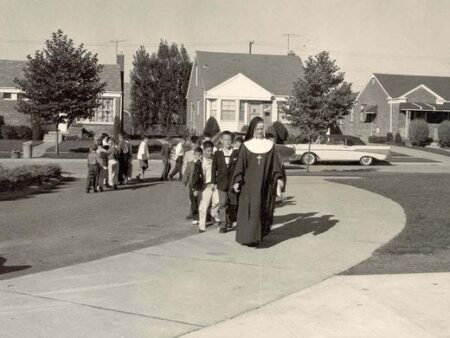In eighth grade I met Sister Francis Marion, six feet tall, wrapped in the blue cloth of the Order of the Immaculate Heart of Mary (IHM), whose look of displeasure could make ice melt. She might have spoken Jack Aubrey’s words to us on the first day and it would have made perfect sense. Raised to believe in our innate sinfulness, his words said in Sister’s voice would have set the tone for the year and for all the years when Sisters stood before us and endeavored to teach us. We would not have blinked:
“ Men must be governed! …. You’ve come to the wrong shop for anarchy ….”
For twelve years, in three schools, I was taught by priests, the occasional civilian and nuns, most often nuns. They were members of the teaching orders, IHM’s and the Bernadines. Sometimes I think those Sisters were as responsible as our parents in how we were raised. We certainly spent more concentrated time under their eyes, inside their worlds.
 They were strange to look at, although that never occurred to us. Their dress cloaked every part of them from our eyes except their faces and hands. Their expressions and voice and the rose scent of their passing when they walked the aisles — this is how we measured them. Body language meant nothing except for their capacity for stillness, for an immobility that could instantly make us silent and sometimes too in the ferocity of their movement toward some poor soul who had incurred their wrath. They showed a flair for the dramatic. They knew how those ‘habit skirts’ could whirl in a turn, how their eyes, confined by their Serre-te and Cap could become like a raptor’s.
They were strange to look at, although that never occurred to us. Their dress cloaked every part of them from our eyes except their faces and hands. Their expressions and voice and the rose scent of their passing when they walked the aisles — this is how we measured them. Body language meant nothing except for their capacity for stillness, for an immobility that could instantly make us silent and sometimes too in the ferocity of their movement toward some poor soul who had incurred their wrath. They showed a flair for the dramatic. They knew how those ‘habit skirts’ could whirl in a turn, how their eyes, confined by their Serre-te and Cap could become like a raptor’s.
Often, our Grammar School* classes reached numbers that are received with skepticism when described to others — one Sister and 60, 70, 80 even 90 children, packed in long rows of two or three, boys separated from girls, each of us seated by alphabet, the boys in ties and jackets, the girls in white blouses and skirts that always contained blue.
Some of our classes, especially several at Holy Name, were barbarous. In the worst of those, the boys, only ever the boys, acted like cherubic mobs, utterly cruel in our exploitation of weakness for the sake of entertainment. Fifty years after high school graduation and I still look back on those moments with such shame. We did need to be governed.
Some Sisters could also be cruel or had reached the end of their considerable patience and just snapped. Some of those stories of rulers and slaps and fear are true. But most, so many, almost all, almost every one — how to write that sentence to reflect the rarity of such punishment?
 More than anything else, in facing the overwhelming challenge of their class numbers, in being paid a pittance for their devotion, in serving a patriarchy of priests, many of whom were less competent (or worse), they persevered and they educated us, many of whom would be the first generation of children from our families to go on to college. Many were exceptional in the sharpness of their intelligence, their knowledge of their subject and in their skill in handling a classroom and individual children.
More than anything else, in facing the overwhelming challenge of their class numbers, in being paid a pittance for their devotion, in serving a patriarchy of priests, many of whom were less competent (or worse), they persevered and they educated us, many of whom would be the first generation of children from our families to go on to college. Many were exceptional in the sharpness of their intelligence, their knowledge of their subject and in their skill in handling a classroom and individual children.
However, we were shaped out of our rude clay in grammar school through an almost alchemical process. In grades 1 through 8, we were taught how to focus, and that attribute, more than any other gave me and my classmates an edge.
Focus and concentration can be used interchangeably. I prefer focus. For me it carries with it the connotation of a concentrated range of attention into which all one’s powers of intellect and emotion can be directed. The Sisters taught us to focus through their absolute demand on our attention in class. Working with such enormous class numbers, they had to have us with them or risk a cascading effect of distraction that may even grow into disorder, the class gathering itself for a mutiny. That sounds absurd doesn’t it, a mythic remembrance, a scene from a bad pre-teen movie. It is not. I was present in classes that went as wild as scenes at a circus when the animals see a chance to escape and take it. All because the nun had lost control.
Keeping focus matters most over time.
We did not change rooms. Only rarely did another teacher come in to instruct us. We sat in those chairs with one Sister over the course of 7 or 8 hours and ran the gamut of Science, Religion, History, English, Geography, Penmanship, Math and Art. Sometimes we ate lunch at our desks (at recess we ran like maniacs) We flipped from one subject to another. An experienced Sister moved us through a seamless day with measures of enthusiasm, love and fear. Most of us learned how to learn because we had no choice but to do so.
When my turn came to lead classes in 1975, to prepare lessons and units, to manage 35 and 40 high school students at a time, my ability to deep focus (and my sense of humor and inner samurai … or inner Sister) kept me afloat until I had some years under my belt and grew out of looking as if I was 12. I am convinced I would not have made it as a teacher without 12 years of Sisters behind me.
 I owe … No, we owe, all of those who moved together, grade to grade, we owe all those Sisters our thanks for helping to raise us, for looking past our persistent halfwit bouts of foolishness, for helping us to understand how to think, and for coming in day after day for 30, 40, 50 years and giving generations of children their devotion. These are their names: Sister Marie Cosmos, Sister Michael Regina, Sisters Jude and Prudence and Assunta, Sister Angeline and Sister Francis Thomas Marion.
I owe … No, we owe, all of those who moved together, grade to grade, we owe all those Sisters our thanks for helping to raise us, for looking past our persistent halfwit bouts of foolishness, for helping us to understand how to think, and for coming in day after day for 30, 40, 50 years and giving generations of children their devotion. These are their names: Sister Marie Cosmos, Sister Michael Regina, Sisters Jude and Prudence and Assunta, Sister Angeline and Sister Francis Thomas Marion.
*Unlike public schools, Catholic Schools in the 50’s, 60’s and 70’s organized their instruction in buildings around only two age groups or classes: grades 1 through 8 attended a grammar school. Grades 9 through 12, high school. For example, I attended St. Gertrude’s in Lebanon (now St. Cecilia’s), and Sacred Heart in West Reading and then Holy Name High School (now Berks Catholic).
** Class Size: A first grade class at Sacred Heart, with boys and girls with whom I later graduated, topped off at 101. That is not a misprint. It is not an exaggeration. Sister Cosmos taught the class. I think her name is appropriate.
Mr. Dobroskey: Post 300